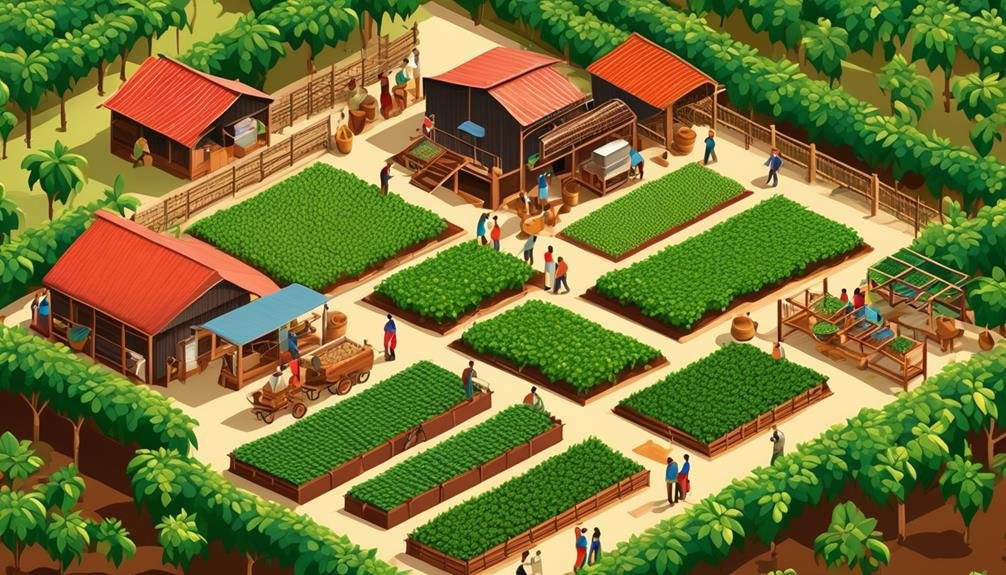So, you've heard the buzz about wet processing for coffee beans, but what exactly does it entail?
Well, imagine a method that involves water, fermentation, and meticulous attention to detail. This process, dating back centuries, plays a crucial role in shaping the final flavor profile of your favorite cup of joe.
But why is wet processing so important? And how does it differ from other methods?
In this discussion, we'll dive into the fascinating world of wet processing, uncovering its history, steps involved, and the impact it has on the sustainability of coffee production.
Get ready to embark on a journey that will forever change the way you appreciate your morning brew.
Key Takeaways
- Wet processing, also known as washed processing, is a widely used method in the coffee industry to remove the outer layers of the coffee cherry and extract the beans inside.
- Wet processing originated in Ethiopia and Yemen centuries ago as a way to achieve a cleaner and brighter flavor profile by fermenting the coffee cherries in water.
- The wet processing method involves several steps, including sorting and inspecting the cherries, pulping to remove the outer skin, fermentation to break down the mucilage, rinsing, drying, and hulling.
- Wet processing benefits the overall quality and flavor of coffee beans by removing undesirable flavors, enhancing aroma, ensuring consistency, extending shelf life, and highlighting delicate and nuanced flavors.
What Is Wet Processing?
Wet processing is a method used in the coffee industry to remove the outer layers of the coffee cherry and extract the coffee beans inside. This process is also known as washed processing and is widely regarded as one of the most effective ways to produce high-quality coffee.
The wet processing method begins with freshly harvested coffee cherries being sorted and then placed into a water-filled tank. The cherries are then passed through a pulper, which removes the skin and pulp, leaving behind the coffee beans. These beans are then transferred to fermentation tanks, where they're soaked in water for a specific period of time. During fermentation, enzymes break down the remaining pulp and mucilage, resulting in a clean and well-rounded flavor profile.
After fermentation, the beans are thoroughly washed to remove any remaining residue. This step is crucial as it ensures the removal of any unwanted flavors that may be present. Once washed, the coffee beans are spread out to dry either on raised beds or drying patios. This drying process can take up to two weeks, depending on the climate and desired moisture content.
History of Wet Processing
The history of wet processing in the coffee industry dates back centuries, with its origins rooted in the ancient coffee-growing regions of Ethiopia and Yemen. The process of wet processing, also known as washed processing, was developed as a means to remove the fruity pulp surrounding the coffee bean and achieve a cleaner, brighter flavor profile. It's believed that the technique was first practiced by Ethiopian farmers, who'd ferment the coffee cherries in water before removing the pulp and drying the beans. This method spread to Yemen, where it became an integral part of the coffee trade.
During the 15th century, Arab traders brought coffee to the Arabian Peninsula and introduced wet processing to the region. The process then made its way to Europe through the spread of coffee cultivation and trade. Wet processing quickly gained popularity due to its ability to produce a more consistent and desirable flavor compared to the natural or dry processing method.
Over time, wet processing became the preferred method for producing high-quality coffee beans, especially in regions with favorable climatic conditions. Today, wet processing is widely practiced in coffee-growing countries across the world, including Central and South America, Africa, and Asia. It has become an essential step in the coffee production process, ensuring the production of specialty coffees with distinct and complex flavors.
Steps Involved in Wet Processing
To begin the wet processing of coffee beans, the harvested cherries are sorted and meticulously inspected for quality. This step is crucial in ensuring that only the best cherries move forward in the process. Any cherries that are overripe, underripe, or damaged are removed, as they can negatively impact the overall quality of the final product.
Once sorted, the cherries are placed in water tanks or channels, where they undergo a process called pulping. In this step, the outer skin of the cherry is removed, revealing the mucilage-covered beans inside.
The beans are then fermented in water tanks for a specific period of time, usually between 12 and 48 hours. During fermentation, enzymes break down the remaining mucilage and any remaining impurities are washed away.
After fermentation, the beans are thoroughly rinsed and then dried either by natural sunlight or using mechanical dryers. This drying process can take several days, and it's important to ensure that the beans are dried to the correct moisture content to prevent any mold or mildew growth.
Once dried, the coffee beans are hulled to remove the parchment layer and any remaining dried mucilage. Finally, the beans are sorted again to remove any defects or foreign matter before they're ready for roasting.
Benefits of Wet Processing
With wet processing, the coffee beans undergo a meticulous and thorough cleaning process that ultimately enhances the overall quality and flavor of the final product. Here are four benefits of wet processing:
- Improved flavor: Wet processing removes the outer layers of the coffee cherry, leaving behind only the high-quality beans. This process helps to eliminate any undesirable flavors that may be present on the surface of the beans, resulting in a cleaner and more vibrant cup of coffee.
- Consistency: Wet processing allows for greater control over the fermentation and washing stages, ensuring that each batch of coffee beans is processed in a consistent manner. This helps to maintain a consistent flavor profile from one batch to another, providing a reliable and predictable product for coffee lovers.
- Enhanced aroma: The careful removal of the mucilage during wet processing allows the true aroma of the coffee beans to shine through. This results in a more aromatic cup of coffee, with distinct and enticing aromas that can be enjoyed even before taking the first sip.
- Extended shelf life: Wet processing involves a thorough cleaning and drying process, which helps to remove any potentially harmful bacteria or mold from the coffee beans. This extends the shelf life of the beans, ensuring that they remain fresh and flavorful for a longer period of time.
Impact on Flavor Profile
Wet processing significantly influences the flavor profile of coffee beans by extracting the full range of delicate and nuanced flavors inherent in the beans. This method involves removing the cherry pulp before drying the beans, allowing for a cleaner and more pronounced taste. Through wet processing, the beans are able to fully express their unique characteristics, resulting in a more complex and vibrant cup of coffee.
One of the key ways wet processing enhances the flavor profile is by reducing the presence of undesirable flavors. By removing the cherry pulp and fermenting the beans, any potential off-flavors are eliminated, resulting in a cleaner and more enjoyable taste. Additionally, wet processing allows for the preservation of the bean's natural sweetness. The fermentation process helps to break down the sugars in the cherry, infusing the beans with a subtle sweetness that adds depth and complexity to the final brew.
Furthermore, wet processing helps to highlight the nuanced flavors that are inherent in the beans. By carefully controlling the fermentation and washing stages, specific flavors can be emphasized. For example, beans processed using the washed method tend to have a brighter and more acidic profile, while those processed using the honey or pulped natural methods often exhibit a richer and more full-bodied taste.
Wet Processing Vs. Other Methods
Other methods of coffee processing differ from wet processing in terms of the overall impact on flavor and the specific characteristics they bring out in the beans. Here are the key differences between wet processing and other methods:
- Dry Processing: Also known as natural processing, this method involves drying the coffee cherries in the sun before removing the husk to reveal the beans. This process typically results in a fuller body and a more pronounced fruity or wine-like flavor profile. However, it can also lead to inconsistencies in flavor and a higher risk of defects due to the prolonged exposure to the elements.
- Semi-dry Processing: Also known as pulped natural or honey processing, this method combines elements of both wet and dry processing. The cherries are partially pulped, leaving some of the fruit intact during the drying process. This method can enhance the sweetness and complexity of the coffee, while also maintaining some of the characteristics of the original fruit.
- Semi-washed Processing: This method involves removing the skin and pulp from the cherries before allowing them to ferment for a short period. The beans are then washed to remove any remaining residue. This process can produce a clean and balanced cup with a medium body and subtle flavors.
- Experimental Processing: There are various experimental processing methods being explored in the coffee industry, such as carbonic maceration, anaerobic fermentation, and yeast fermentation. These methods aim to push the boundaries of flavor and create unique profiles that highlight specific characteristics of the beans.
Understanding the differences between wet processing and other methods can help coffee enthusiasts appreciate the diverse range of flavors and profiles that exist within the world of coffee.
Sustainability and Wet Processing
To ensure the long-term sustainability of wet processing, it's crucial to implement environmentally friendly practices that minimize water usage and prevent pollution. Wet processing uses a significant amount of water, making it essential to find ways to reduce this consumption. One approach is to implement water recycling systems, where the water used in one stage is treated and reused in subsequent stages. This not only reduces water usage but also helps to prevent pollution by minimizing the discharge of wastewater into rivers and streams. Additionally, using natural methods to filter and treat the wastewater can further enhance sustainability.
Another aspect of sustainability in wet processing is the proper disposal of coffee cherry pulp, which is a byproduct of the process. This pulp can be used as organic fertilizer, providing a sustainable solution for its disposal. By composting the pulp, it not only helps to reduce waste but also provides valuable nutrients to the soil, promoting healthy plant growth.
Furthermore, promoting sustainable farming practices, such as shade-grown coffee, can contribute to the overall sustainability of wet processing. Shade-grown coffee helps to conserve biodiversity, prevent soil erosion, and reduce the need for chemical fertilizers and pesticides.
Ultimately, by implementing environmentally friendly practices and promoting sustainable farming methods, the wet processing of coffee beans can continue to thrive while minimizing its impact on the environment.
Frequently Asked Questions
How Does Wet Processing Affect the Caffeine Content of Coffee Beans?
Wet processing affects the caffeine content of coffee beans by removing the outer layers that contain higher concentrations of caffeine. This process results in a decrease in caffeine levels, producing a milder flavor in the final cup of coffee.
Can Wet Processing Be Done at Home by Coffee Enthusiasts?
Yes, as a coffee enthusiast, you can definitely try wet processing at home. It involves removing the fruit pulp from the coffee cherries, fermenting them, and then washing them to reveal the coffee beans.
Are There Any Disadvantages or Drawbacks to Wet Processing Coffee Beans?
There are a few disadvantages to wet processing coffee beans. It requires a lot of water and can be time-consuming. Additionally, if not done properly, it can lead to fermentation issues and impact the flavor of the final cup.
Does Wet Processing Have Any Impact on the Shelf Life of Coffee Beans?
Wet processing, a method used to remove the outer layer of coffee beans, can have an impact on the shelf life. By washing away the mucilage, it reduces the chances of fermentation and mold growth, which can extend the coffee's freshness.
Are There Any Specific Regions or Countries Known for Their Expertise in Wet Processing Coffee Beans?
There are specific regions and countries known for their expertise in wet processing coffee beans. These areas have perfected the art of wet processing, resulting in unique flavors and high-quality coffee.
Conclusion
In conclusion, wet processing is a method used to remove the outer fruit and pulp from coffee beans. This process involves several steps, including fermentation, washing, and drying.
Wet processing has been practiced for centuries and is known for producing a cleaner and brighter flavor profile in coffee. Compared to other processing methods, wet processing requires more water and energy but offers higher quality and consistency.
Additionally, wet processing can be sustainable when implemented with eco-friendly practices.




